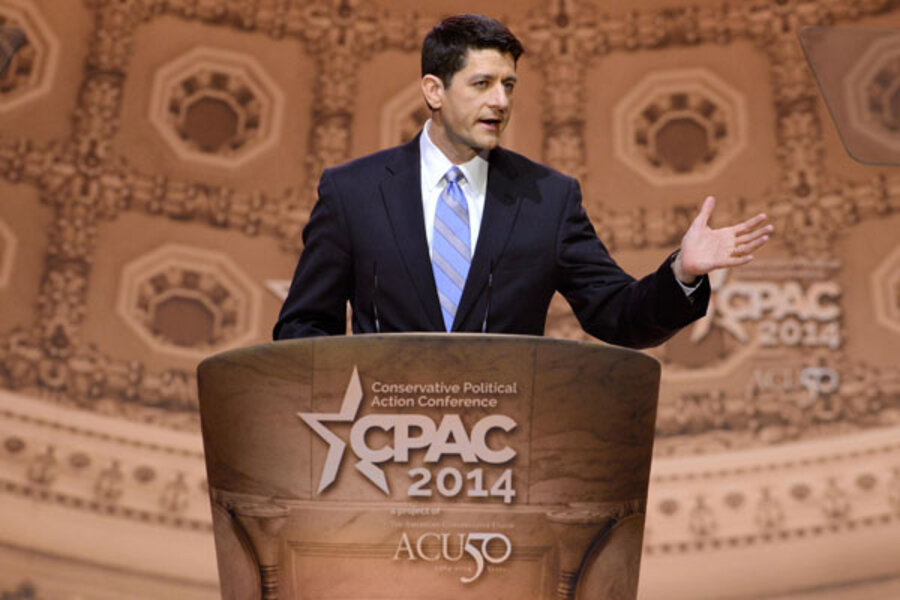Ryan budget's clear message: We're not Democrats
Loading...
| Washington
The balanced budget put forward by Rep. Paul Ryan (R) of Wisconsin Tuesday looks like legislation designed to pass Congress, but it's not. It has no chance of passing the Democrat-controlled Senate.
The same goes for fresh Democratic efforts to push for fair pay for women and a raise in the minimum wage. They’re likely to be unpalatable to Republicans.
But the two contrasting approaches to the economy are hardly worthless, even if they're going nowhere legislatively. In truth, they exist more as campaign messages to motivate the base to vote in a year when a shift of six seats could change control of the US Senate.
"So little of what Congress does is legislation and so much of what it does is message," says Ross Baker, a congressional expert at Rutgers University in New Brunswick, N.J. With women's pay equity, the Democrats are perpetuating the Republican "war on women," which worked very effectively for them in 2012, he says. And with the Ryan budget, the idea is that the Republicans are serious about entitlement reform.
"It's a question of dueling messages," he says.
Turnout is always key to winning elections, but midterm voting patterns put Democrats at a disadvantage. In the past three midterm elections, voter turnout has hovered around 37 percent – almost 20 points lower than in presidential years, says Amy Black, a political scientist at Wheaton College in Illinois. Seniors are more likely to vote than younger people, and whites more than nonwhites – patterns that favor Republicans.
But does using bills as levers to increase turnout work?
The “blueprint” by House Budget Chairman Ryan is meant to show a party serious about debt control, entitlement reform, and job growth – all core conservative concerns. But analysts suggest the budget might hurt more than help Republicans.
Ryan's plan could be a “double-edged sword,” cautions Jennifer Duffy, who watches Senate races for the nonpartisan Cook Political Report. “He makes changes to Medicare which provide Democrats with an opening to go after their candidates,” she says.
“Right now, what’s motivating Republican voters and continues to, is health care,” she says.
The Ryan budget – called “The Path to Prosperity” – would “expand opportunity by growing the economy.” The plan cuts $5.1 trillion in spending over 10 years, claims to balance the budget in that same amount of time, lowers the corporate and top individual tax rates to 25 percent, increases defense spending, and revives a voucher-like Medicare program for future retirees.
Democrats had their knives drawn Tuesday.
“It would end Medicare as we know it,” Senate majority leader Harry Reid (D) of Nevada said.
Rep. Chris Van Hollen of Maryland, the top Democrat on the House Budget Committee, lambasted the budget for its “fake balance” by repealing the Affordable Care Act, yet still relying on the ACA's $1.7 trillion in revenues and savings. He pointed to slashed spending on education, food assistance, and health care for the poor.
Looking ahead to November, however, voter enthusiasm appears worse for the Democrats. The Democrats’ proposals, dubbed “a fair shot for everyone,” aim to help and motivate a sinking middle class. That's a tall order.
Democratic pollster Celinda Lake puts no varnish on the outlook: Democrats are at a sharp disadvantage this year, with only 57 percent saying they are “extremely likely” to vote versus 64 percent for Republicans, according to the Battleground Poll she recently worked on. But she feels confident about one thing: Democrats are on the right messaging track.
“The Democrats are so discouraged and so feeling like nothing is happening for them, that I think the best way to have turnout is to give them concrete measures that will make their lives better,” Ms. Lake says.
The measures laid out by Senate Democrats last week hit those notes: pay equity for women, a higher federal minimum wage, more affordable college, untrammeled Medicare, less costly child care, and investment in infrastructure.
This agenda can appeal to groups who turned out to help reelect President Obama in 2012 but generally are less likely to show up for midterms – unmarried women, young people, Latinos, and African Americans. What also helps is that one of the Democrats' issues – a higher minimum wage – is figuring in several gubernatorial races and is on some state ballots. This includes a handful of states with tight Senate races, such as Michigan, Arkansas, and Alaska, says Lake. If voters come to the polls to support higher state minimum wages, they will be in place to support Democratic Senate candidates.
Republicans counter that the slate of Democratic proposals does nothing more than “paper over” the “symptoms of malaise,” as Senate minority leader Mitch McConnell (R) of Kentucky said Tuesday. He said the proposals don’t treat the cause of joblessness, as Republicans aim to do with their pro-growth approach of tax cuts, debt reduction, and the repeal of the Affordable Care Act.
For both Republicans and Democrats, “these plans are about motivating partisans rather than persuading the undecided,” says John Pitney, a political scientist at Claremont McKenna College in California. In the end, the proposals will have only a “marginal” affect on the elections, he says. “The two things that matter most are the state of the economy and President Obama's approval rating.”
If the economy improves, and if the president's numbers go up, Democrats might be able to trim the Republican turnout advantage, Professor Pitney says. If the economy and presidential approval both head south, then Republicans will gain ground.






